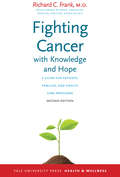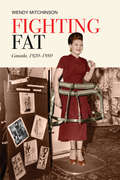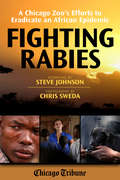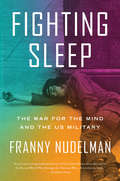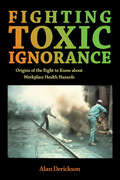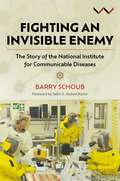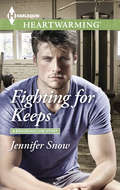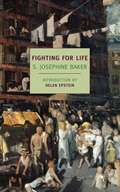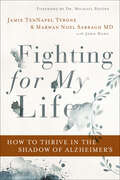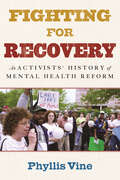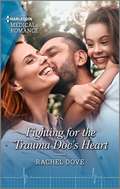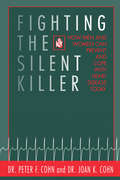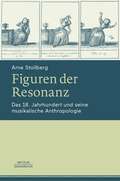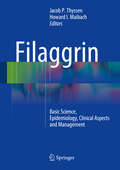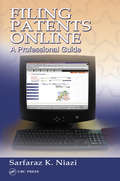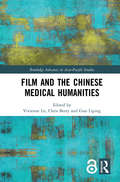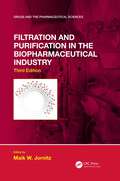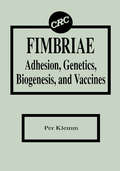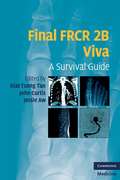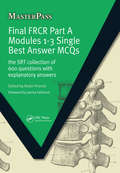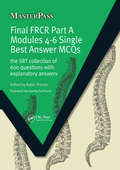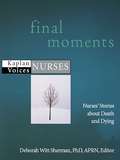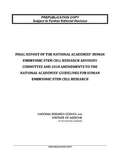- Table View
- List View
Fighting Cancer with Knowledge and Hope
by Richard C. FrankAnyone who is diagnosed with cancer receives a frightening blow, and in many cases the diagnosis is accompanied by a bewildering array of treatment opyions. In this invaluable book, Dr Richard C. Frank offers comfort and help to cancer patients, their families and their carers. An award-winning oncologist recognised for his humanitarian approach as well as his research, Dr Frank empowers patients by unlocking the mysteries of the disease and explaining in plain language how to confront and combat it. he explains what cancer is and how it spreads, how the different treatment options work and what factors affect a patient's prognosis. With a wealth of case histories, helpful coping strategies and up-to-date information about useful resources, Fighting Cancer is the book cancer patients and their loved ones can turn to with confidence and hope. 'An important resource for patients, caregivers and healthcare professionals . . . It demonstrates the author's astute knowledge coupled with profound compassion. '- PHYLLIS OSTERMAN, The Leukemia and Lymphoma Society'This book simplifies the language of cancer medicine and its related science to a level that allows most patients and family members to understand the important concepts needed to make decisions about treatment and overall care,'-ANN A. JAKUBOWSKI, Ph. D. , M. D. , Memorial Sloan-Kettering Cancer Center
Fighting Fat: Canada, 1920-1980
by Wendy MitchinsonWhile the statistics for obesity have been alarming in the twenty-first century, concern about fatness has a history. In Fighting Fat, Wendy Mitchinson discusses the history of obesity and fatness from 1920 to 1980 in Canada. Through the context of body, medicine, weight measurement, food studies, fat studies, and the identity of those who were fat, Mitchinson examines the attitudes and practices of medical practitioners, nutritionists, educators, and those who see themselves as fat. Fighting Fat analyzes a number of sources to expose our culture’s obsession with body image. Mitchinson looks at medical journals, both their articles and the advertisements for drugs for obesity, as well as magazine articles and advertisements, including popular "before and after" weight loss stories. Promotional advertisements reveal how the media encourages negative attitudes towards body fat. The book also includes over 30 interviews with Canadians who defined themselves as fat, highlighting the emotional toll caused by the stigmatizing of fatness.
Fighting Rabies
by Steve Johnson Chris SwedaThis book comprises a series of Chicago Tribune articles on the Lincoln Park Zoo's partnership with the Serengeti Health Initiative to eradicate the spread and infection rate of rabies in Tanzania. Complete with full-color photography of the villagers, their homes, and the surrounding African wildlife and landscapes, Fighting Rabies is a powerful and illustrative investigation into the efforts to eliminate a vicious disease in a ravaged community.Over 70,000 people die every year from rabies infections, many of whom live in remote and impoverished areas of Africa. This epidemic-prevalent in communities close to wildlife but limited in their access to health and veterinary care-is particularly tragic because rabies can be significantly limited and even prevented through modern medicine. In fact, several developed countries are now completely rabies-free, while developing nations still face unnecessarily high rates of mortality from the disease.Fighting Rabies explores the stories of the villagers who have been victimized by rabies, as well as the efforts of researchers from the Lincoln Park Zoo to inoculate dogs against the virus and rebuild the surrounding populations of wild animals. This is a captivating and moving story of bridging cultures for a greater good, and creating better living conditions for both people and the neighboring wildlife.
Fighting Sleep: The War for the Mind and the US Military
by Franny NudelmanHow the military used sleep as a weapon—and how soldiers fought backOn April 21, 1971, hundreds of Vietnam veterans fell asleep on the National Mall, wondering whether they would be arrested by daybreak. Veterans had fought the courts for the right to sleep in public while demonstrating against the war. When the Supreme Court denied their petition, they decided to break the law and turned sleep into a form of direct action. During and after the Second World War, military psychiatrists used sleep therapies to treat an epidemic of “combat fatigue.” Inducing deep and twilight sleep in clinical settings, they studied the effects of war violence on the mind and developed the techniques of brainwashing that would weaponize both memory and sleep. In the Vietnam War era, radical veterans reclaimed the authority to interpret their own traumatic symptoms—nightmares, flashbacks, insomnia—and pioneered new methods of protest. In Fighting Sleep, Franny Nudelman recounts the struggle over sleep in the postwar world, revealing that sleep was instrumental to the development of military science, professional psychiatry, and antiwar activism. Traversing the fields of military and mainstream psychiatry, popular and institutional film, documentary sound technology, brain warfare, and postwar social movements, she demonstrates that sleep—far from being passive, empty, or null—is a site of contention and a source of political agency.
Fighting Toxic Ignorance: Origins of the Right to Know about Workplace Health Hazards
by Alan DericksonFighting Toxic Ignorance explores conflict over access to information regarding health hazards encountered in the US workplace during the first three-quarters of the twentieth century. Alan Derickson considers risks posed by toxic chemicals and physical and biological agents of disease. By the 1970s, occupational disease was estimated to kill up to 100,000 Americans a year. Derickson unravels the social and political forces and the conflictual process that gave rise to a sustained social movement for a workers' right to know about often-insidious threats. He argues that the decades prior to the emergence of this movement were not a dark age of victimization brought about by enforced ignorance but a time of recurrent battles over the disclosure of needed facts. Workplace warnings—informative signs, labels, and instructions—often saved lives. Fighting Toxic Ignorance covers a broad range of dangerous substances, deals with a large share of the national workforce, and illuminates the many ways that activists endeavored to see that warnings reached workers, especially immigrants and workers of color.
Fighting an Invisible Enemy: The Story of the National Institute for Communicable Diseases
by Barry SchoubFighting an Invisible Enemy narrates the founding in 2002 and growth of the internationally renowned centre of excellence for communicable diseases, the National Institute for Communicable Diseases (NICD) in South Africa. In a continent riven with a panoply of formidable contagious pathogens, the book describes how the nascent NICD travelled a rocky road to maturity. Starting humbly, as did many of its sister public health institutions around the world, the road was strewn with daunting obstacles of financial restrictions, bureaucratic straitjacketing, international isolation during the apartheid era and, in later years, the calumny of governmental AIDS denial. Following the triumph of the eradication of the once-dreaded smallpox, the NICD now plays a crucial role in the global effort to eradicate poliomyelitis. While the country has the misfortune of the largest HIV/AIDS pandemic in the world, the Institute’s HIV research unit has become a world leader. More remote from public notice are the laboratories and support epidemiologists carry out for ongoing surveillance of communicable diseases and the alerts they provide for any signal of an impending outbreak or pandemic. The Institute’s value to public health was clearly shown in the recent Covid-19 pandemic. The maxim that we are only safe when everyone everywhere is safe, underlines the importance of international partnerships and the key role the NICD plays, not only for the country but also for global health. This is a flagship organisation in public health in South Africa and this book paints a vivid portrait of its incredible accomplishments.
Fighting for Keeps
by Jennifer SnowHe's kryptonite. And she needs all her strength... Noah Parks is the ridiculously gorgeous, motorcycle-riding, cage-match-fighting equivalent of kryptonite for Lindsay Harper. And she's going to need every last ounce of her strength now that she's the legal guardian of her brother's five orphaned children. For the sake of her new family, it's time to give up her carefree single ways. Stop being the cool aunt and become a parent. And fight this crazy attraction to Noah. Sure, there's a side of him she can't help falling for...the one who volunteers as a firefighter and helps at-risk youth. The irresistibly kind and caring side. But she is a nurse, after all. She can't love an MMA fighter, a man she regularly has to scan for physical trauma... Can she?
Fighting for Life
by S. Josephine Baker Helen EpsteinNew York's Lower East Side was said to be the most densely populated square mile on earth in the 1890s. Health inspectors called the neighborhood "the suicide ward." Diarrhea epidemics raged each summer, killing thousands of children. Sweatshop babies with smallpox and typhus dozed in garment heaps destined for fashionable shops. Desperate mothers paced the streets to soothe their feverish children and white mourning cloths hung from every building. A third of the children living there died before their fifth birthday.By 1911, the child death rate had fallen sharply and The New York Times hailed the city as the healthiest on earth. In this witty and highly personal autobiography, public health crusader Dr. S. Josephine Baker explains how this transformation was achieved. By the time she retired in 1923, Baker was famous worldwide for saving the lives of 90,000 children. The programs she developed, many still in use today, have saved the lives of millions more. She fought for women's suffrage, toured Russia in the 1930s, and captured "Typhoid" Mary Mallon, twice. She was also an astute observer of her times, and Fighting for Life is one of the most honest, compassionate memoirs of American medicine ever written.
Fighting for My Life: How to Thrive in the Shadow of Alzheimer's
by John Hanc Jamie TenNapel Tyrone Marwan Noel SabbaghA practical, helpful guide on how to fight back against Alzheimer&’s disease—with expert medical advice and one woman&’s inspiring personal journey.Jamie Tyrone was forty-nine years old when she learned by accident through genetic testing that she had a 91% chance of getting Alzheimer's disease. She was shocked, but after an initial bout with depression she decided to take action rather than concede defeat.Jamie teamed up with Dr. Marwan Sabbagh, a renowned neurologist, and together they created a resource detailing not just Jamie's experience, but expert medical advice for anyone facing the disease.This book is a practical, helpful guide for those who know they&’re at greater risk of contracting Alzheimer&’s disease. With cutting-edge medical guidance from Dr. Sabbagh about the true nature of Alzheimer&’s, the risks involved, and daily steps you can take to protect yourself, Jamie&’s story will encourage and empower you.In Fighting for My Life, readers will:Gain expert medical advice from Dr. Sabbagh on how to fight back against the diseaseDiscover the pros, cons and possible dangers of genetic testingWitness a first-hand account of how to deal with the shadow of Alzheimer&’s disease through Jamie&’s storyIf Alzheimer&’s has affected your life or the life of someone you know, this book is for you. You&’ll be armed with information and ready to tackle Alzheimer&’s head-on.
Fighting for Recovery: An Activists' History of Mental Health Reform
by Phyllis VineAn essential history of the recovery movement for people with mental illness, and an inspiring account of how former patients and advocates challenged a flawed system and encouraged mental health activismThis definitive people&’s history of the recovery movement spans the 1970s to the present day and proves to readers just how essential mental health activism is to every person in this country, whether you have a current psychiatric diagnosis or not.In Fighting for Recovery, professor and mental health advocate Phyllis Vine tells the history of the former psychiatric patients, families, and courageous activists who formed a patients&’ liberation movement that challenged medical authority and proved to the world that recovery from mental illness is possible.Mental health discussions have become more common in everyday life, but there are still enormous numbers of people with psychiatric illness in jails and prisons or who are experiencing homelessness—proving there is still progress to be made.This is a book for youA friend or family member of someone with serious psychiatric diagnoses, to understand the history of mental health reformA person struggling with their own diagnoses, to learn how other patients have advocated for themselvesAn activist in the peer-services network: social workers, psychologists, and peer counselors, to advocate for change in the treatment of psychiatric patients at the institutional and individual levelsA policy maker, clinical psychologist, psychiatric resident, or scholar who wants to become familiar with the social histories of mental illness
Fighting for the Trauma Doc's Heart: Pacific Paradise, Second Chance / Fighting For The Trauma Doc's Heart (Mills And Boon Medical Ser.)
by Rachel DoveFrom professional rivals…To a family of three?Ex-army doc Jacob Peterson is still adjusting to life as a single dad when his job is threatened by returning trauma doc Michelle Forbes. The sparks of animosity with the smart, sassy doc soon turn to attraction. But there’s room in Jacob’s life for only one girl—his daughter—and he can’t risk her heart, or his, again. Resisting his growing bond with Michelle will be the fight of his life!
Fighting the Silent Killer: How Men and Women Can Prevent and Cope with Heart Disease Today
by Dr Peter Cohn Dr Joan CohnAmericais number-one killer, heart disease, can exist in the absence of symptoms. Calledlent heart disease,�ts first manifestations can be catastrophic. This no-nonsense guide now addresses this and other new issues in a clear, non-technical way and examines old concerns from a fresh perspective. The text moves easily from the role of smoking, st
Figuren der Resonanz: Das 18. Jahrhundert und seine musikalische Anthropologie
by Arne StollbergAb der Mitte des 17. Jahrhunderts vollzog sich in der Medizin ein Paradigmenwechsel von hoher ästhetischer Relevanz. Hatten die Nerven bis dahin als Transportkanäle für die „Lebensgeister“ gegolten, so trat nunmehr eine konkurrierende Theorie auf den Plan, nach der es sich um elastische Fasern handle, die in Analogie zur Saitenvibration, also über das Prinzip der Schwingung zu erklären seien. Der menschliche Leib avancierte buchstäblich zu einem Musikinstrument, das emotionale Erleben (nicht nur) von Musik zu einem Resonanzeffekt. Die Folgen dieser Sichtweise waren einschneidend: Das vorliegende Buch zeigt anhand zahlreicher Quellen aus den Bereichen Musik, Medizin, Literatur und Ästhetik, wie eine „musikalische Anthropologie“ entstand, die wiederum auf die Kompositionspraxis zurückwirkte, etwa bei Carl Philipp Emanuel Bach, Georg Anton Benda und Wolfgang Amadeus Mozart.
Filaggrin
by Howard I. Maibach Jacob P. ThyssenFilaggrin gene mutations are common in Europeans and their descendants, as well as in Asians, reaching a prevalence of up to 10%. Filaggrin proteins are crucial for skin homeostasis as their metabolites maintain skin hydration, keep the skin pH low, and provide protection against solar radiation. FLG mutation carriers suffer from dry and scaly skin and have an increased transfer of allergens and chemicals across the epidermis. Moreover, they have 10% higher serum vitamin D levels, potentially affecting the propensity to develop other diseases. FLG loss-of-function mutations represent the strongest risk factor hitherto discovered for atopic dermatitis and are major predisposing factors for related asthma and hay fever. This textbook provides comprehensive and detailed coverage of the effects of FLG mutations in health and disease (cutaneous and non-cutaneous) and also discusses the basic science, epidemiology, management, and future research areas.
Filing Patents Online: A Professional Guide
by Sarfaraz K. NiaziThe average cost of an uncomplicated patent application filing is about $10,000. This high cost can leave thousands of inventors out in the cold. Filing Patents Online: A Professional Guide is a complete manual that walks inventors through each step of filing and prosecuting the patent online at a fraction of the cost. The online filing system reco
Film and the Chinese Medical Humanities (Routledge Advances in Asia-Pacific Studies)
by Chris Berry Vivienne Lo Guo LipingFilm and the Chinese Medical Humanities is the first book to reflect on the power of film in representing medical and health discourse in China in both the past and the present, as well as in shaping its future. Drawing on both feature and documentary films from mainland China, the chapters each engage with the field of medicine through the visual arts. They cover themes such as the history of doctors and their concepts of disease and therapies, understanding the patient experience of illness and death, and establishing empathy and compassion in medical practice, as well as the HIV/AIDs epidemic during the 1980s and 90s and changing attitudes towards disability. Inherently interdisciplinary in nature, the contributors therefore provide different perspectives from the fields of history, psychiatry, film studies, anthropology, linguistics, public health and occupational therapy, as they relate to China and people who identify as Chinese. Their combined approaches are united by a passion for improving the cross-cultural understanding of the body and ultimately healthcare itself. A key resource for educators in the Medical Humanities, this book will be useful to students and scholars of Chinese Studies and Film Studies as well as global health, medical anthropology and medical history.
Filtration and Purification in the Biopharmaceutical Industry, Third Edition (Drugs and the Pharmaceutical Sciences)
by Maik W. JornitzSince sterile filtration and purification steps are becoming more prevalent and critical within medicinal drug manufacturing, the third edition of Filtration and Purification in the Biopharmaceutical Industry greatly expands its focus with extensive new material on the critical role of purification and advances in filtration science and technology. It provides state-of-the-science information on all aspects of bioprocessing including the current methods, processes, technologies and equipment. It also covers industry standards and regulatory requirements for the pharmaceutical and biopharmaceutical industries. The book is an essential, comprehensive source for all involved in filtration and purification practices, training and compliance. It describes such technologies as viral retentive filters, membrane chromatography, downstream processing, cell harvesting, and sterile filtration. Features: Addresses recent biotechnology-related processes and advanced technologies such as viral retentive filters, membrane chromatography, downstream processing, cell harvesting, and sterile filtration of medium, buffer and end product Presents detailed updates on the latest FDA and EMA regulatory requirements involving filtration and purification practices, as well as discussions on best practises in filter integrity testing Describes current industry quality standards and validation requirements and provides guidance for compliance, not just from an end-user perspective, but also supplier requirement It discusses the advantages of single-use process technologies and the qualification needs Sterilizing grade filtration qualification and process validation is presented in detail to gain the understanding of the regulatory needs The book has been compilated by highly experienced contributors in the field of pharmaceutical and biopharmaceutical processing. Each specific topic has been thoroughly examined by a subject matter expert.
Fimbriae Adhesion, Genetics, Biogenesis, and Vaccines
by Per KlemmFimbriae are the best-studied bacterial colonization factors. They are of paramount importance in bacterial pathogenesis and microbial ecology. Due to the advent of new and powerful techniques, an impressive amount of information has been accumulated on these important surface organelles over the last decade. The first book of its kind, Fimbriae brings together into one volume the state of the art of this very active field. Internationally recognized researchers give both a horizontal and lateral approach to fimbriology. Selected types of fimbriae are extensively reviewed and fundamental questions such as evolution, control or regulation, biogenesis, bacteria-host interaction, and fimbriae-based vaccines are examined.
Final Epidemic
by Earl MerkelCauses: Unknown. At first, they thought it was a cold or maybe the flu. Then people started dropping where they stood. Symptoms: Unthinkable. It could kill in hours. There was no known cure, no vaccine, and the only antidote could kill millions.
Final FRCR 2B Viva
by Jessie Aw John Curtis Kiat Tsong TanFinal FRCR 2B Viva: A Survival Guide presents a series of cases similar to those used in the FRCR exams and representative of everyday radiological practice. This invaluable collection of high quality images is accompanied by clear and concise explanations, enabling trainees to prepare fully for their FRCR 2B viva presentation. Covering the full range of imaging modalities and organ systems, it provides clinically important vignettes which help the reader to impress examiners and colleagues, and enhance the trainee's ability to come up with differential diagnoses. Concise key points for each case provide additional diagnostic information which would impress an examiner. Written by a team of expert consultant radiologists and several recently successful FRCR Part 2 candidates, Final FRCR 2B Viva: A Survival Guide is an essential purchase for all radiology trainees.
Final FRCR Part A Modules 1-3 Single Best Answer MCQS: The SRT Collection of 600 Questions with Explanatory Answers (MasterPass)
by Robin ProctorSingle best answer (SBA) questions have been introduced into the Final FRCR Part A examination of the Royal College of Radiologists in the UK for the first time. This book of 600 SBA questions and explanatory answers has been written to aid students preparing for the exam by current trainees in clinical radiology, coordinated through The Society of Radiologists in Training (SRT). Questions are grouped by topic and each topic is split into three papers of 70 questions, with explanations separated into chapters to enable readers to either attempt a whole mock exam paper or to browse question by question. The book is a bridge between a pure revision aid and a reference text, including a bibliography of useful references for further information. Candidates for other professional exams in Radiology will find the text useful, as will and those from other specialties wishing to explore the radiological aspects of their syllabus in greater depth. This is a companion volume to Final FRCR Part A Modules 4-6 Single Best Answer MCQs by the same team.
Final FRCR Part A Modules 4-6 Single Best Answer MCQS: The SRT Collection of 600 Questions with Explanatory Answers (MasterPass)
by Robin ProctorSingle best answer (SBA) questions have been introduced into the FRCR Part 2A examination of the Royal College of Radiologists in the UK for the first time. This book of 600 SBA questions and explanatory answers has been written to aid students preparing for the exam by current trainees in clinical radiology, coordinated through The Society of Radiologists in Training (SRT). Questions are grouped by topic and each topic is split into three papers of 70 questions, with explanations separated into chapters to enable readers to either attempt a whole mock exam paper or to browse question by question. The book is a bridge between a pure revision aid and a reference text, including a bibliography of useful references for further information. Candidates for other professional exams in Radiology will find the text useful, as will and those from other specialties wishing to explore the radiological aspects of their syllabus in greater depth. This is a companion volume to Final FRCR Part A Modules 4-6 Single Best Answer MCQs by the same team.
Final Moments
by Deborah Witt ShermanWhat was it like the first time a nurse witnessed death? How do nurses cope with death when it becomes almost routine? What lessons can we learn from their experiences? Twenty-five nurses--from hospitals, private practices, and in home health care--tell about their experiences with death. Hear from people new to the field as well as those who have been in nursing for decades about how they deal with grief, the controversies about end-of-life decisions, the challenges of caring for people as they die, and the harrowing experience of telling their family members. Edited and introduced by a registered nurse, the book is a resource for both nurses and anyone who wants to better understands death and dying.
Final Remedy
by Daniel StevenDr. Karen Moore confronts a multimillion-dollar malpractice suit and ugly accusations of racism when a patient dies of an apparent drug overdose, and her only ally is prosecuting attorney Elliot Roth. When a black man dies of an apparent overdose, everyone on the ER staff assumes he's the latest victim of D.C.'s drug epidemic--until he's identified. Now, under ugly accusations of racism, attending physician Dr. Karen Moore has become the target of a multimillion-dollar malpractice suit that could destroy her entire future.
Final Report of the National Academies' Human Embryonic Stem Cell Research Advisory Committee and 2010 Amendments to the National Academies' Guidelines for Human Embryonic Stem Cell Research
by National Research Council Institute of Medicine of the National AcademiesIn 2005, the National Academies released the book, Guidelines for Human Embryonic Stem Cell Research, which offered a common set of ethical standards for a field that, due to the absence of comprehensive federal funding, was lacking national standards for research. In order to keep the Guidelines up to date, given the rapid pace of scientific and policy developments in the field of stem cell research, the Human Embryonic Stem Cell Research Advisory Committee was established in 2006 with support from The Ellison Medical Foundation, The Greenwall Foundation, and the Howard Hughes Medical Institute. As it did in 2007 and 2008, the Committee identified issues that warranted revision, and this book addresses those issues in a third and final set of amendments. Specifically, this book sets out an updated version of the National Academies' Guidelines, one that takes into account the new, expanded role of the NIH in overseeing hES cell research. It also identifies those avenues of continuing National Academies' involvement deemed most valuable by the research community and other significant stakeholders.
